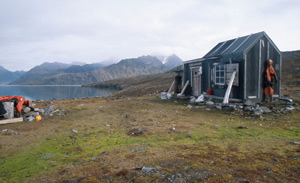 Camp Zöe, an old trapper’s cabin in Krossfjorden, built on contract for the Northern Exploration Company. (Image: Marte Lundberg / The Norwegian Polar Institute)
Camp Zöe, an old trapper’s cabin in Krossfjorden, built on contract for the Northern Exploration Company. (Image: Marte Lundberg / The Norwegian Polar Institute)
Kongsfjorden and Krossfjorden were used by whalers in the 17th century. Kongsfjorden was called Whales Bay by Hudson in 1607 and Deer Sound by Poole in 1610, whereas Krossfjorden was called Close Cove by Poole in 1610. Close Cove was called Close Sound by Daniel in 1612, but Krossfjorden was always known as Kruys (Cross) Sound among the Dutch whalers.
Along the shores of Kongsfjorden and Krossfjorden are several protected cultural heritage sites. At the mouth of Tinayrebukta in Krossfjorden lies Camp Zöe, a cabin erected by Henry Rudi in 1911 by contract for Ernest Mansfield. The trapper’s cabin was, according to Oxaas, named after Mansfield’s daughter, Zöe. During the season of 1911-12 Henry Rudi overwintered at Ebeltofthamna and used the newly built cabin on the other side of the fjord as a supplementary station. The hunter and trapper Rudi was engaged by the Northern Exploration Company (NEC) and served as a watchman for the NEC’s occupations in the area. For this job he earned 50 NOK per month, and half of what he hunted and trapped. In the years up to the banckruptcy of the NEC in 1929 and until it was purchased by the Norwegian state in 1932, hunters and trappers regularly served as watchmen for the NEC’s annexations in Ebeltofthamna and London. Throughout these years Camp Zöe was used as a supplementary station. Today, the cabin is in good shape and is used by the community organisation in Ny-Ålesund.
In Ebeltofthamna (Ebeltoft harbour), on the other side of the fjord from Camp Zöe, a summary of Svalbard’s cultural heritage history may be seen. Around the bay, cultural remains spanning all the historical periods in Svalbard are represented. Ebeltofthamna is a good example of a well suited location re-visited by people throughout the centuries. Good anchorage, safe harbour, lee from winds and weather, proximity to hunting and trapping grounds, good supply of freshwater and driftwood for firewood and building material are common characteristics of locations with cultural remains through the last 400 years of Svalbard’s history.
According to Conway, Ebeltofthamna was the first harbour used by the English in Spitsbergen. It was also the first English whaling station. Remains from the whaling period are found on the long, low beach between the fjord and the lagoon, in the form of a large and tall tryworks (furnace for rendering oil from whale blubber) and remains of a house foundation. On the other side of the mouth of the lagoon lies the old burial ground from the whaling period.
Traces of the later Russian Pomors’ long-standing presence in Ebeltofthamna include a burial ground, the foundations for two Russian Orthodox crosses and a large cluster of houses belonging to a trapping facility. The burial ground lies upon a high brink where the beach meets land. The ruins are found a few hundred metres away. The trapping facility in Ebeltofthamna is comprised of three tight clusters of house ruins. The lushly green sites are found in an otherwise vegetation-free grey, gravel flat. The complex is one of the largest of its kind in Svalbard, comparable in size to the Pomor cultural heritage sites of Trygghamna and Russekeila in the fjord of Isfjorden. Written sources say this was the site for the first Norwegian overwinter trapping, believed to have been conducted in close cooperation with Russian Pomors.
At the north side of the bay in Ebeltofthamna are house foundations, other remains of buildings, technical equipment, large waste dumps, an overturned rowboat and other traces of human occupation. Among these are remains of the German geophysical station built at this site in 1910-11 for an expedition led by Alfred Wegener. The station was in operation from 1912 and until just after the outbreak of World War I in 1914. At the station, the staff recorded seismological measurements and observed tides and ice conditions, cloud altitude, sunlight, and meteorological conditions throughout the year.
Norwegian overwinterings are represented by the remains of a hunters’ cabin used in the 1920s and 1930s. Everywhere in the area lie single objects like pieces of wood and board, rusty tin cans, nails, pieces of iron, cartridge cases, bottles and broken glass.
The cultural remains in Ebeltofthamna are vulnerable and exposed to natural and human induced degradation. On this basis, the authorities are now considering to regulate traffic in this area.
Inwards in Kongsfjorden, along the shore and on the islands and islets, are several cabins or remains of cabins. Worth mentioning is the cabin on the islet of Storholmen, which is of the same type as the ones in London, built as a holiday house for Ernest Mansfield. On the islet of Juttaholmen is a cabin built by Victor Walle and Einar Sletten, from the Kings Bay Company, in 1954-55. The cabin was raised on the site of an old hunter/trapper’s cabin. The islet is named after Jutta Munthe-Kaas, who was housekeeper for Gunnar Isachsen, who mapped the islands in Kongsfjorden during his expeditions in 1909 and 1910. The cabin Gåsebu was built in the 1950s, close to a grave and an old trapper’s cabin, which was falling to pieces. A cabin nicknamed Gorilla was built in the late 1950s by people in Ny-Ålesund. Tyskerhytta, erected by researchers from East Germany in 1965, is still marked DDR. All the cabins are interesting cultural monuments with a unique history of their own.
The beaches along Kongsfjorden and Krossfjorden hold more cultural heritage remains than those mentioned here. Many are described in relation to the landing sites nearest them, in other sections of this handbook.